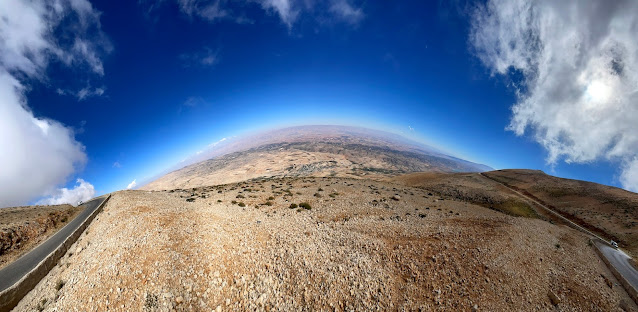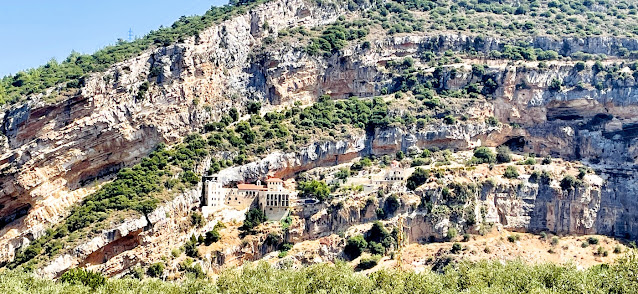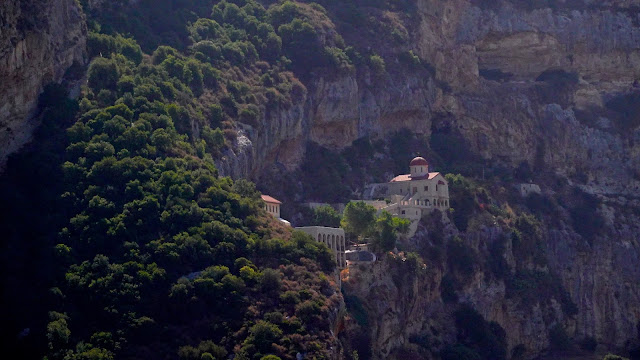This post sees me a drive from An Nakhlah to Baalbek via Hamatoura Monastery, The Maronite Patriarchate and the Cedars Of God Bsharri.
Today was my favourite day so far. What a drive. Through the mountains of Lebanon. What a contrast. I was mostly alone on the road, nice villages, views to die for and a cool dry climate that saw the car aircon go off and the car windows come down.
Hamatoura Monastery is built into the top of a mountain just like Mega Spileo Monastery in Kalavrita Greece and Ostrog Monastery in Montenegro. What a task to get there. Drive to a power station near the village of Kousba (84km from Beirut) and walk 2km whilst climbing 200m using close to 1,000 steps. The church of Saint Jacob is the most ancient part of the monastery, belonging to the 4th century, while a large cross from the 7th century rises above the outer doorway. Late in the 13th century, at Our Lady Monastery in Hamatoura, Saint Jacob began his ascetic life. Later, when the monastery was destroyed by the Mamlukes, he re-established monasticism along the perimeter of the ruined monastery. In time, he rebuilt the monastery; regenerating and giving renewed vigour to monastic life in the area. His spiritual briskness, vivacity, and popularity among believers drew the attention of the Mamelukes who set their minds to stop his verve and determination and force him to convert to Islam. He stubbornly refused their relentless pressures. The Mamlukes killed him and burned the church. Today, believers and pilgrims are constantly reporting his apparitions, miraculous healings and other Grace-filled deeds.
The Maronite Patriarchate near Dimane is the official residence and offices of the Maronite Church in Lebanon. It is heavily guarded so I could not visit and had to film it from an apple orchard hidden from the guards. The Maronite Church is an Eastern Catholic church in full communion with the pope and the worldwide Catholic Church, with self-governance. The current head of the Maronite Church is Patriarch Bechara Boutros al-Rahi, who was elected in March 2011. Establishment of the Maronite Church can be divided into three periods, from the 4th to the 7th centuries. Although reduced in numbers today, the distinct but related Maronite ethno-religious group remains a principal grouping in Lebanon, with smaller minorities of Maronites in Syria, Cyprus, Israel, and Jordan. Emigration since the 19th century means that by about two-thirds of the Maronite Church's roughly 3.5 million members in 2017 were located outside "The Antiochian's Range", where they are part of the worldwide Lebanese diaspora.
The Cedars Of God Bsharri is THE PLACE to see the classic Cedars of Lebanon, a tree that grows at high altitude (2000m +) and has a classic upturned shape and on the Lebanese Flag. This is UNESCO protected forest because these cedars date back thousands of years. The Phoenicians, Israelites, Egyptians, Assyrians, Babylonians, Persians, Romans, Arabs, and Turks used Lebanese timber. The Egyptians valued their timber for shipbuilding, and in the Ottoman Empire their timber was used to construct railways.
The highlight of my journey today was crossing the Nessef el batrak Bsharri Pass at almost 2,500m that intersects the Lebanon Mountain Ridge that cuts through the middle of the country. What a view. I saw clouds passing me in a cool 15C climate with near 30C down below on either side. Only the images below can attest to the beauty of this pass. Here there is no junk, derelict buildings or traffic – just uninterrupted views of both sides of Lebanon. From here you can see most of the country notwithstanding that Lebanon is only 15% the size of Tazzie but this ridge follows a line 2,500m up which is way way higher than anything in Tazzie and even Kosciusko at 2,352m. This ridge is home to Mt Lebanon, the highest peak at 3,088m. On the other side was the city of Baalbek, which I will explain after the following amazing images of central mountainous Lebanon…
Baalbek (Pop 82,608, Elev 1170m, Founded 330 BC) is a city with a rich ancient past. Alexander The Great founded it as Heliopolis in 330BC as he conquered Asia. In the 1st Century BC the Romans built a huge religious complex in the city dedicated to Jupiter, Venus and Bacchus, the Roman God of Wine. This complex, now known as the Baalbek Roman Ruins is a huge well-preserved UNESCO protected archaeological site. The temples of Venus and Jupiter have largely fallen having been toppled by two earthquakes and the Ottoman occupation. The temple of Bacchus on the other hand is still largely standing. It has no roof but most of its pillars and cornices are still upright mainly because the columns were oversized. This Roman site lasted until the 4th Century AD when it fell under the second earthquake devastating the Temples of Jupiter and Venus. Early Byzantine Christians built a church on the site of fallen Jupiter in the 5th Century AD and eve shipped one of Jupiter’s columns to Constantinople where it now stands in the Church of Agia Sofia. Finally the Ottomans used the site as a citadel from the 11th to 14th Centuries AD. Baalbek is hot in summer but a lot more confortable with no humidity and call mornings and nights given its 1170m elevation. Baalbek has coffee expresson machines on every street corner but no fresh milk just condensed if you want a Latte. Most people drink short espresso. Baalbek is also only 14km from the Syrian border with many refugees working here and lots of checkpoints to boot. I ran through 3 checkpoints in my 10km run and later met 7 waiters working in a big café restaurant that I visited for a break. The rest of the modern city is chaotic and very unkept. Baalbek is lucky it has the ruins, which put it on the map and is keeping it economically alive.
Enjoy the Roman ruins of Baalbek…

















































No comments:
Post a Comment